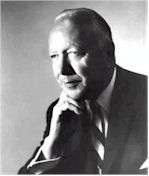Julius Adams Stratton
Julius Adams Stratton (May 18, 1901 – June 22, 1994)[1] was a U.S. electrical engineer and university administrator. He attended the University of Washington for one year, where he was admitted to the Zeta Psi fraternity, then transferred to the Massachusetts Institute of Technology (MIT), from which he graduated with a bachelor's degree in 1923 and a master's degree in electrical engineering (EE) in 1926. He then followed graduate studies in Europe and the Technische Hochschule of Zürich (ETH Zurich), Switzerland, awarded him the degree of Doctor of Science in 1927.[2]
Julius Adams Stratton | |
|---|---|
 | |
| 11th President of Massachusetts Institute of Technology | |
| In office 1959–1966 | |
| Preceded by | James Rhyne Killian |
| Succeeded by | Howard Wesley Johnson |
| 1st Chancellor of Massachusetts Institute of Technology | |
| In office 1956–1959 | |
| President | James Rhyne Killian |
| Succeeded by | Paul E. Gray |
| Personal details | |
| Born | May 18, 1901 Seattle, Washington |
| Died | June 22, 1994 (aged 93) Boston, Massachusetts |
| Nationality | American |
| Residence | United States |
| Alma mater |
|
| Awards | IEEE Medal of Honor (1957) Faraday Medal (1961) |
| Scientific career | |
| Fields | Electrical engineering |
| Institutions | Massachusetts Institute of Technology |
| Thesis | Streuungskoeffizient von Wasserstoff nach der Wellenmechanik (1927) |
| Doctoral advisor | Paul Scherrer |
Professional biography
He published the classic book "Electromagnetic Theory" as part of the McGraw-Hill series in Pure and Applied Physics in 1941. It has been re-issued by the IEEE.
He served as the president of MIT between 1959 and 1966, after serving the university in several lesser posts, notably appointments to provost in 1949, vice president in 1951, and chancellor in 1956. He also served as the chairman of the Ford Foundation between 1964 and 1971. In 1967, Stratton was seconded to chair a Congressionally established "Commission on Marine Sciences, Engineering and Resources" whose work culminated in a report, "Our Nation and the Sea", published in 1969, that had a major influence on ocean sciences and management in the United States and abroad. The commission itself became commonly referred to as the Stratton Commission.
Stratton was also a founding member of the National Academy of Engineering.[3]
Stratton collected his speeches in a 1966 book titled Science and the Educated Man: Selected Speeches of Julius A. Stratton (Cambridge, Mass.: MIT Press, 1966), with a foreword by the historian of technology Elting E. Morison who had been on the faculty of MIT as a professor of humanities in the Sloan School of Industrial Management from 1946 to 1966.[4]
MIT's Julius Adams Stratton Student Center at 84 Massachusetts Avenue is named in his honor.
References
- "President Emeritus Julius Adams Stratton dies at 93".
- Stratton, Julius Adams (1928). Streuungskoeffizient von Wasserstoff nach der Wellenmechanik [Scattering coefficient of hydrogen after wave mechanics] (Ph.D.). Eidgenössische Technische Hochschule Zürich. OCLC 720868304 – via ProQuest.
- "Founding members of the National Academy of Engineering". National Academy of Engineering. Retrieved October 21, 2012.
- Honan, William H., "Elting E. Morison, 85, Educator Who Wrote Military Biographies", The New York Times, April 26, 1995
Sources
- Johnson, Howard W. (March 1996). "Julius Adams Stratton (18 May 1901-22 June 1994)". Proceedings of the American Philosophical Society. 140 (1): 116–121. JSTOR 987282.
External links
- IEEE History Center- IEEE minibio of Julius Stratton
- Full text of the final Stratton Commission report, "Our Nation and the Sea"
- Julius Adams Stratton at the Mathematics Genealogy Project
| Academic offices | ||
|---|---|---|
| New office | Chancellor of the Massachusetts Institute of Technology 1956 – 1959 |
Vacant Title next held by Paul E. Gray |
| Preceded by James Rhyne Killian |
President of the Massachusetts Institute of Technology 1959 – 1966 |
Succeeded by Howard Wesley Johnson |